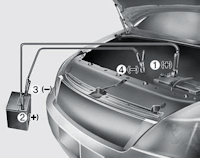EV jump start Your Kia electric vehicle (EV) uses a 12-volt battery to actually start the car, much like a 12-volt battery is used to start an internal combustion engine (ICE) vehicle. Plus an EV jump start is possible! If the start battery has died, you will be locked out of your car. You can …
Tag: Kia
Permanent link to this article: https://dashboardsymbols.com/2025/07/new-video-posted-on-kia-ev-jump-starting/
Permanent link to this article: https://dashboardsymbols.com/2025/06/kia-ev-jump-start-process/
The two forms of auto brake hold
Brake hold We’ve now experienced two very different forms of Auto Brake Hold, and only recently adjusted the page to reflect it, 20 different images not withstanding. In any case, some manufacturers have the system active at all times. If the car is started, brake hold is ready to use by default. This was the …
Permanent link to this article: https://dashboardsymbols.com/2025/06/the-two-forms-of-auto-brake-hold/
Complaint filed with #NHTSA
NHTSA A few days ago, I alluded to attempting to work with Kia on what I believe should be a warranty issue. I was rebuffed by both a local dealer and the company itself. So today I filed a detailed complaint with NHTSA, the National Highway Traffic Safety Administration. I will give you a detailed …
Permanent link to this article: https://dashboardsymbols.com/2025/05/complaint-filed-with-nhtsa/
My only real complaint about the Kia Niro EV
Kia Niro EV If I have a single complaint regarding the Kia Niro EV I now drive, its the obnoxiously loud back-up warning the VESS (Virtual Engine Sound System) system gives off. And I’m not alone. The rules in the U.S. state that “The vehicle must make a continuous noise level of at least 56 …
Permanent link to this article: https://dashboardsymbols.com/2025/04/my-only-real-complaint-about-the-kia-niro-ev/
Dog Mode is slowly spreading
Dog Mode I have a friend who has had some recent headaches with her Tesla and has threatened to move on to another vehicle. But, she wonders why no one else has Dog Mode, which she makes great us of. Dog Mode allows the temperature in the car to be set, keeping the vehicle interior …
Permanent link to this article: https://dashboardsymbols.com/2024/11/dog-mode-is-slowly-spreading/
Kia symbols page gets the new color treatment
Kia symbols page On the heels of finding another half dozen symbols that were not included in the owner’s manual list, we have transformed our Kia symbols page into the new color alignment. The addition of the new symbols, discussed here as an owner’s manual fail, the page now holds exactly 100 entries. We’ve now …
Permanent link to this article: https://dashboardsymbols.com/2024/11/kia-symbols-page-gets-the-new-color-treatment/




New video posted on Kia EV jump starting
EV jump starting Today we posted a new video on our YouTube channel describing Kia EV jump starting. With it, we made a new playlist, calling the video the first of what we hope will be a series of videos on the topic. In truth, its the second, but we didn’t realize the first one …
Continue reading